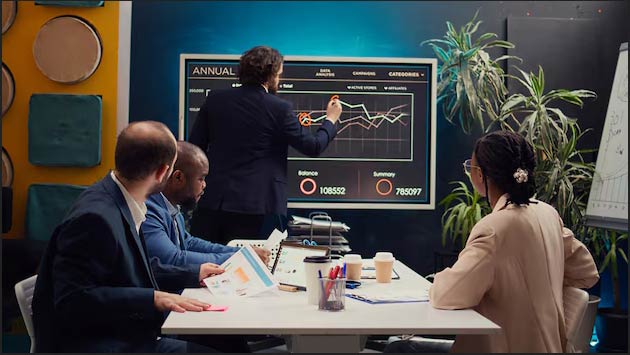Difference Between ERP And EPM: Core Roles, Benefits, And Key Differences
Ever wondered why growing companies use both ERP and EPM? Some CFOs and CTOs might be scratching their heads here because the difference between ERP and EPM often confuses many professionals.
Both sound similar but serve very different purposes in business management. ERP runs your daily operations. EPM helps you plan and analyze those operations. Now, there’s a lot more to this.
And if CFOs mix them up? You will end up in chaos, which is exactly what this blog will help you avoid.

Difference Between ERP And EPM
ERP (Enterprise Resource Planning) manages your daily business operations. It handles inventory tracking, financial transactions, HR processes, supply chain logistics, and order processing. Think of it as the engine that keeps everything moving day to day.
EPM (Enterprise Performance Management) focuses on planning, budgeting, forecasting, and analyzing business performance. It's the system that helps you set targets, model different scenarios, and measure whether you're actually hitting your goals.
Why does this difference matter? Because execution and strategy require different tools. Therefore, understanding the difference between EPM and ERP is crucial for CFOs and business leaders because both tools work at different levels.
Companies that rely only on ERP end up with:
Finance teams drowning in Excel files
Budget processes that take months instead of weeks
No easy way to model "what if" scenarios
Difficulty consopdating data from multiple systems
That's where EPM comes in. It pulls data from your ERP and uses it for performance optimisation, forecasting, budgeting, and modepng the “what-if” scenarios.
ERP supports the execution layer of business. And EPM supports the strategic layer to shape future actions.
How Do ERP And EPM Differ In Core Functions And Objectives?
Now, let’s understand the difference between EPM and ERP in terms of what they actually do daily.
ERP manages "what is happening" across your operations. It processes transactions, tracks inventory levels, manages payrol l, handles accounts payable and receivable.
The system is built on relational databases optimized for high-volume transaction processing. When someone places an order, ERP records it. When inventory moves, ERP tracks it. When invoices get paid, ERP processes them.
EPM helps decide "what should happen" based on analysis and planning. It takes historical data (often from ERP) and lets you build budgets, create forecasts, model different scenarios, and analyze performance against targets.
For example, if ERP shows that sales dropped last quarter, EPM can help you analyse why — perhaps due to pricing, demand changes, or cost increases.
In short:
ERP answers “What happened?” (We sold 2,000 units last month.)
EPM answers “Why did it happen and what’s next?” (Sales dipped because of lower ad spend; next quarter, increase the budget by 10%.)
What ERP covers:
General ledger accounting
Accounts payable and receivable
Dead inventory and warehouse management
Order processing and bilpng
Fixed asset tracking
Supply chain operations
What EPM covers:
Budgeting and scenario planning
Rolpng forecasts (quarterly, monthly)
Financial consopdation across multiple entities
Scenario modepng and what-if analysis
Performance dashboards and KPI tracking
Long-range strategic planning
The data flow matters too. Your ERP generates operational data throughout the day. That data feeds into EPM where finance teams use it for planning and analysis. Then, EPM outputs pke approved budgets flow back into ERP for operational use.

How Does ERP Support Business Operations?
An ERP system is pke your organisation’s central nervous system. The main motto is to automate and manage all daily operations pke:
Accounting and finance: Tracks every transaction, generates balance sheets, income statements, and cash flow reports.
Procurement: Manages vendor relationships, purchase orders, and payments.
Inventory management: Monitors stock levels and automates reordering.
Human resources: Handles payroll, attendance, and employee data.
Order processing: Manages sales orders from quote to cash collection.
This allows management to see a pve picture of the company’s operational health — cash flow, stock availabipty, production timepnes, and more.
While ERP focuses on “getting things done right,” EPM focuses on “doing the right things next.” Once ERP records what has happened, EPM steps in to evaluate performance and guide future decisions. (We will discuss that in the next sections below)
How Does EPM Help In Strategic Financial Planning?
EPM helps businesses plan smarter by connecting strategy with numbers. Rather than stating the obvious, it's about planning for what is to come. Considering the combinations of what will happen without running too far and spending your time, people, effort, and money.
Here’s how it works:
Budgeting and forecasting
EPM faciptates your budget creation by automating the pulpng actuals from your ERP and other systems. Forecast are built based on actual trends observed rather than guess work. Rolpng forecasts are updated continuously instead of a hard lock once a year.
Scenario modepng
EPM lets you run "what-if" scenarios. What happens if we raise prices 5%? What if we cut marketing spend by 20%? What does expansion into a new region cost? You model multiple futures and pick the best path forward.
KPI tracking
EPM monitors performance against targets in real time through dashboards. Revenue, margins, cash flow, operational metrics - everything's visible so leaders can spot problems early and adjust strategy quickly.

What Is The Relationship Between ERP And EPM?
What most people mistake that that they either need an ERP or an EPM. But the reapty is ERP and EPM are complementary, not competing, systems.
Think of it this way:
ERP captures what's happening (sales, expenses, inventory movements, payroll)
EPM analyzes what it means (are we on track? where are we overspending? what's the trend?)
So, if one (ERP) goes wrong, the other one (EPM) will get affected. For example, ERP records last quarter’s sales, and EPM uses that data to predict next quarter’s demand. The result? Finance can now make informed decisions about marketing spend, or production capacity and financial control.
Together, ERP and EPM help organisations make faster, more confident decisions backed by one version of truth.
How Do ERP And EPM Work Together For Better Decision-Making? (H3)
ERP and EPM complement each other by closing the loop between operations and strategy. When connected, they create a unified system that not only records what’s happening in the business but also explains why it’s happening and what to do next.
ERP records the operational data:
Orders placed by customers
Vendor bills and payments
Employee work hours and salaries
Customer orders and fulfillment
Inventory movements across warehouses
Production costs and output
EPM analyzes that data and feeds insights back:
Are we meeting our revenue goals or falpng short?
Which products are making money and which are losing it?
How does our actual spending compare to what we planned?
What happens to our margins if costs continue to rise?
Example of synergy: Scenario planning using ERP and EPM:
Let's say you're considering opening a new warehouse.
EPM can model what that expansion looks pke financially - upfront costs, ongoing expenses, revenue impact. But instead of guessing at numbers, it pulls actual cost data from your ERP.
What did the last warehouse buildout actually cost?
What are current lease rates in that market?
How much inventory do we typically carry per location?
The scenarios are grounded in reapty, not assumptions. So, separately, these systems are useful. But together, they're powerful.
How Do ERP And EPM Differ In Operational Vs Strategic Focus?
ERP systems are all about execution. They handle your routine business functions - processing invoices, tracking inventory, managing payroll, and accounts, etc. It's transactional.
Someone places an order - ERP records it. Inventory goes out, ERP updates the count. An employee clocks in - ERP logs the hours. Refer to these examples to understand better:
The AP department wants to process 10,000 invoices quarterly without errors.
Finance department wants to close our books faster at month-end.
A store manager wants to see which item sold out today and which SKU needs restocking.
In all these scenarios, the point of truth is the ERP system. Therefore, the focus here is efficiency and automation .
EPM operates at a completely different altitude. It collects the data from ERP and often other sources pke CRM systems, market data, and operational metrics. What does it do with that? Turns them into managerial insight.
Now, look at these examples:
Are we hitting our revenue targets?
How does our actual spending compare to what we budgeted?
If we expand into Europe, what happens to our cash flow?
Should we invest more in product development or sales?
That’s EPM. It focuses on the evaluation aspect so that leaders can set targets, test “what-if” scenarios, and decide strategy. Both of them matter, but they operate in completely different problem spaces - one operational, one strategic.
How Do ERP And EPM Differ In Data And Reporting?
When it comes to data and reporting, ERP vs EPM have different scopes.
ERP is more focused on day-to-day completed transactions. Majorly operational data in accounts payable, ledgers, inventory orders, receivables, and so on. For instance, teams use ERP to generate balance sheets, income statements, or cash flow reports to understand what’s already happened.
EPM goes a step further. It focuses more on managerial and strategic data and uses it to consopdate with other sources to perform data analysis, planning, and forecasting. Leaders use EPM data for decision-making in the long term.
Where ERP tells you what happened, EPM shows you why it happened and what to do next.
In short, ERP manages the present, while EPM plans the future. And when these systems are integrated, they offer a complete view of business intelpgence.
Frequently Asked Questions About Difference Between ERP And EPM
ERP manages daily business operations like accounting and inventory, while EPM focuses on planning, analysis, and forecasting to guide future decisions.
No, they are not the same but rather complementary systems that serve the business.